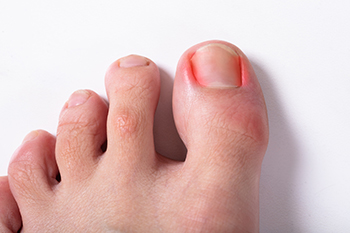
Ingrown toenails occur when the edge of the nail grows into the surrounding skin, often leading to pain, redness, swelling, and sometimes infection. Common causes include improper nail trimming, wearing tight shoes, injury, or genetic predisposition. The affected toe, usually the big toe, may feel tender to the touch and appear red or swollen, sometimes with drainage or pus, if infected. Walking can become uncomfortable or even painful. A podiatrist can diagnose the condition through a physical exam and recommend appropriate treatment. Mild cases may be managed with proper nail care and antibiotics, if infection is present. For recurring or severe cases, surgical options, such as partial or full nail removal or removal of the nail root, may be necessary. Aftercare typically includes keeping the area clean, applying medication, and wearing open-toed or loose-fitting shoes to allow healing. If you have a painful ingrown toenail, it is suggested that you schedule an appointment with a podiatrist to relieve pain and prevent complications.
Ingrown toenails may initially present themselves as a minor discomfort, but they may progress into an infection in the skin without proper treatment. For more information about ingrown toenails, contact Vrunda Dalal, DPM of Sole Focus Foot and Ankle. our doctor can provide the care you need to keep you pain-free and on your feet.
Ingrown Toenails
Ingrown toenails are caused when the corner or side of a toenail grows into the soft flesh surrounding it. They often result in redness, swelling, pain, and in some cases, infection. This condition typically affects the big toe and may recur if it is not treated properly.
Causes
- Improper toenail trimming
- Genetics
- Improper shoe fitting
- Injury from pedicures or nail picking
- Abnormal gait
- Poor hygiene
You are more likely to develop an ingrown toenail if you are obese, have diabetes, arthritis, or have any fungal infection in your nails. Additionally, people who have foot or toe deformities are at a higher risk of developing an ingrown toenail.
Symptoms
Some symptoms of ingrown toenails are redness, swelling, and pain. In rare cases, there may be a yellowish drainage coming from the nail.
Treatment
Ignoring an ingrown toenail can have serious complications. Infections of the nail border can progress to a deeper soft-tissue infection, which can then turn into a bone infection. You should always speak with your podiatrist if you suspect you have an ingrown toenail, especially if you have diabetes or poor circulation.
If you have any questions, please feel free to contact our office located in Marlton, NJ . We offer the newest diagnostic and treatment technologies for all your foot care needs.

